These sailboat blocks will be sailing just across the state line from South Carolina to North Carolina to Emily, our January charity queen, who will be making quilts for Project Linus. After the blocks were made, I realized the sky fabric, Rustic Weave in Turquoise, I had chosen was fairly dark.
After the blocks were made, I realized the sky fabric, Rustic Weave in Turquoise, I had chosen was fairly dark.  I thought the sky fabric paired well with the water fabric, a Kona Cotton solid in Peacock.
I thought the sky fabric paired well with the water fabric, a Kona Cotton solid in Peacock.  These sailboats were fun to make and they are on their way to Emily at The Darling Dogwood.
These sailboats were fun to make and they are on their way to Emily at The Darling Dogwood.
Author: quiltedblooms
Galaxy Star in Fandangle Fabric
Jen gave us the freedom to choose any block we wanted to make but gave us a few suggestions. In this post, she choose several from Quilter’s Cache where there are quilt blocks galore!
I choose the Galaxy Star 9″ paper pieced block.

For colors, Jen requested the tertiary colors and I have the perfect fabrics. These three prints are from Christa Watson’s new fabric line, Fandangle by Benartex.
The two tone on tone prints are Crosshatch in light grey and teal. And print is Triangle Trinkets in teal.

I had fun brushing up on my paper piecing skills and even managed to keep the background fabric oriented correctly.
Karen made a woven star block for Jen and I’m looking forward to seeing more!
Li’l Shamrocks for Jennifer
Saint Patrick’s Day has come and gone, but I finally have made a couple of little shamrock blocks to be included in the border of Jennifer’s quilt.

These little shamrocks measure just 4 1/2″, so sewn into the quilt they will be 4″.

I used a Cotton and Steel print, Dottie in Picnic green, and another green, a print from Hazel by Alison of Cluck, Cluck, Sew.

You see, Jennifer is continuing her theme from 2017. Her block from March 2017 was Irish Eyes.
And one more pic of a little shamrock.

These are in the mail to Jennifer and I can’t wait to see her finished quilt.
Scrappy Strips Block for Ann
Ann requested a Scrappy Strip Block finishing 12″ square using a white background and brightly colored scraps. She posted about the block here and wrote a detailed tutorial on her blog Brown Paws Quilting here.
I grabbed some scraps and made this block.

I almost took the easy way out and made a cross but wanted the challenge and inserted the second strip at an angle. It looks nice and straight at this angle…
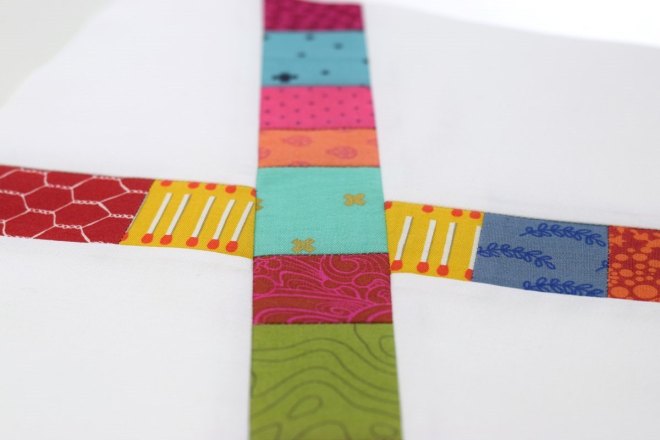
But what about from the other angle? Success, I did keep the strip lined up fairly well.

Even though Ann requested two strips in each block, I had enough scraps sewn to make one additional strip so I inserted a single strip in a block and thought she could add in another strip.

Now to catch up on my other bee blocks!
I Spy Block Tutorial {Teenage Version}
March is my month to be queen for Bee Inspired. I have chosen an easy peasy block using just two fabrics. This rectangle block is used by permission from a fellow Greenville MQG member, Didi at DidiQuilts.com.
I’m calling it a Teenage I Spy block.
Finished size 8 x 12, (unfinished 8 1/2″ x 12 1/2″)

My local traditional guild is making charity quilts for girls of all ages up to teenage who are living at a home for children. The plan is to give each girl a quilt which they can then take with them when they are old enough to leave. I want to make a larger lap quilt for a teenager.
Fabrics – Block Center
For the block center anything goes. Feel free to use novelty prints, low volume prints, or anything that inspires you.
Fabrics – Framing Fabric
For the frames or borders please use solids in the following colors:
Pink, Purple, Blue, Aqua, and Gray – Feel free to use lights, mediums and darks in any shades or tones.
My only prerequisite is that I would like for the fabrics to be prewashed. Prewashing is easy if you follow my tutorial for prewashing a small amount of fabric.
Cutting the Fabric
From the novelty fabric used for the center of the block, cut:
(1) rectangle 4 1/2″ x 8 1/2″
From the framing fabric, cut:
(4) rectangles 2 1/2″ x 8 1/2″
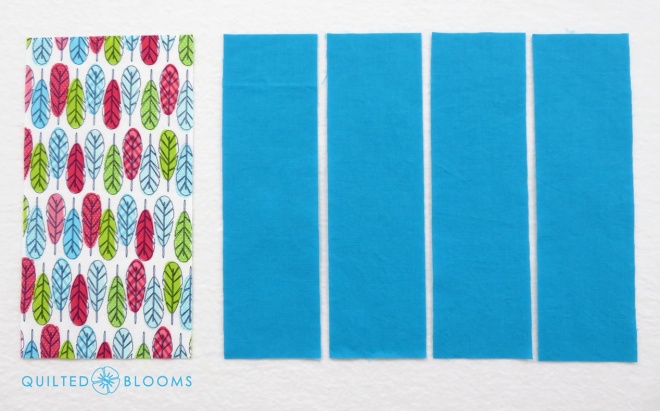
Piecing
Sew (1) framing rectangle to each of the long sides of the central rectangle. Press seams towards the framing fabric.
Tip: When sewing the framing rectangles onto the central rectangle, sew with the framing rectangles on the bottom. That way, if the central rectangle was cut on the lengthwise grain, the framing rectangles will has less opportunity to stretch as you are piecing.

Sew the remaining (2) rectangles to the top and bottom of the block and press the seams, again, toward the framing fabric. And, tada, you are done! Here are some I Spy blocks I have made.

Feel free to make a many as you like, because I will need 42 blocks which will make a lap quilt in a 6 x 7 block layout measuring 56″ x 72″. I’m looking forward to seeing what you make.
Quatrefoil Block
Sharon from Yellow Cat Quilt Designs chose the Quatrefoil Block as the January 2018 bee block. She requested colors in pinks, turquoise, blue, green, yellow and coral with a white background as she would be making a Project Linus charity quilt.

The white background is Moda Bella Solid and I used prints by Cotton and Steel and Tula Pink. Don’t you think they play well together?
 Making the Quatrefoil block was a first for me and came together nicely. If you would like to make your own Quartrefoil block, a link to the free pdf pattern is in this blog post by Jennie at Clover & Violet.
Making the Quatrefoil block was a first for me and came together nicely. If you would like to make your own Quartrefoil block, a link to the free pdf pattern is in this blog post by Jennie at Clover & Violet.
Now to make a bookshelf block for Emily and I’ll be all caught up for a brief moment!
Planted Pines ~ November Bee Block
I live among pine trees, planted Loblolly pines, with my husband on his family’s century farm so for my block I decided to design a pine tree block, Planted Pines. It was a gorgeous fall day, just look how blue the sky was in this unedited photo.
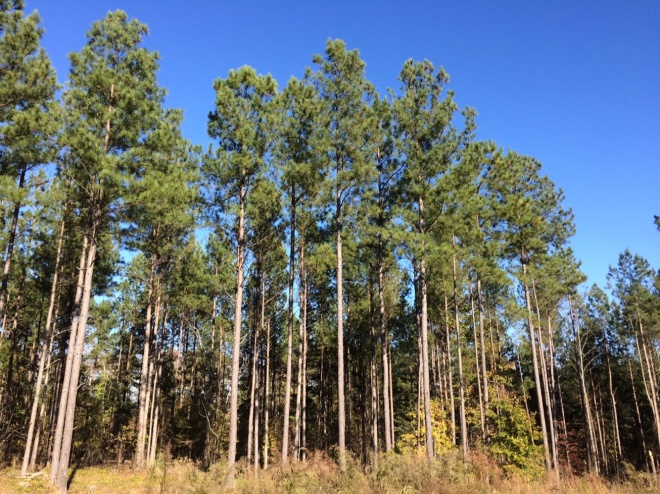 These pines have just been thinned (for the 2nd time) and will be clear-cut in another 10 years or more. Then, the process of planting and cutting will start all over again making forestry a natural renewable resource.
These pines have just been thinned (for the 2nd time) and will be clear-cut in another 10 years or more. Then, the process of planting and cutting will start all over again making forestry a natural renewable resource.
In the tree farming business, the tallest and straightest pines trees are most desirable bringing the most money at saw mill. That’s why I designed my Planted Pines quilt block to be tall and lean just like the pine trees.
Planted Pines Blocks
Planted Pines blocks finish at exactly 6″ in width and approximately 18″ in height (give or take). Unfinished size is 6 1/2″ x 18 1/2″. The blocks are constructed from flying geese units, a tree trunk section and the ground, or more commonly referred to around here as red hills in the upstate of South Carolina.
Here are a few examples of planted pines blocks. As you can see, they can be constructed from two, three or four flying geese units or half triangles if you wish. How large or small and the degree of the angle for the ground is up to you. You are welcome to add a bit of background to increase the length of your Planted Pines block.
 Planted Pines are constructed from a variety of more earthy greens in solids, tone-on-tones and prints with very little colors other than neutrals. There are exceptions, a tree would be beautiful in this Kaffe Fassett print which includes a little purple.
Planted Pines are constructed from a variety of more earthy greens in solids, tone-on-tones and prints with very little colors other than neutrals. There are exceptions, a tree would be beautiful in this Kaffe Fassett print which includes a little purple.
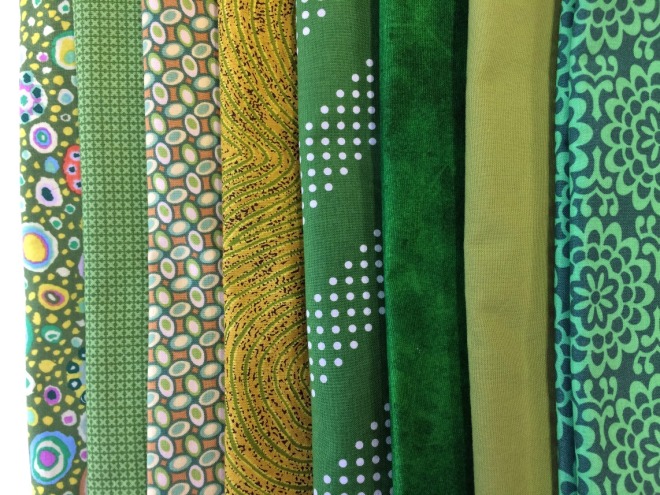 For the tree trunks, any browns from solids to tone-on-tones will work fine. And for the backgrounds please use creams, light tans, light gray, white or low volume. Here are some examples.
For the tree trunks, any browns from solids to tone-on-tones will work fine. And for the backgrounds please use creams, light tans, light gray, white or low volume. Here are some examples.
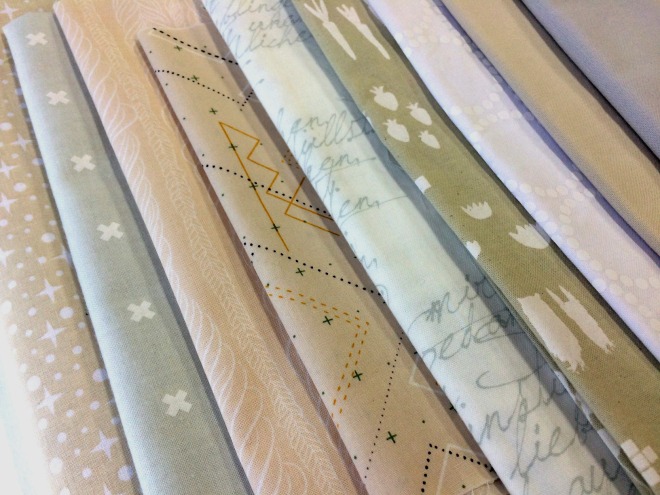 Fabric for the ground or red clay has been mailed to everyone. It’s burnt orange from In The Beginning Fabrics. I included 2 patches should you be industrious, but one will be appreciated.
Fabric for the ground or red clay has been mailed to everyone. It’s burnt orange from In The Beginning Fabrics. I included 2 patches should you be industrious, but one will be appreciated.
I’ve made two blocks so far…
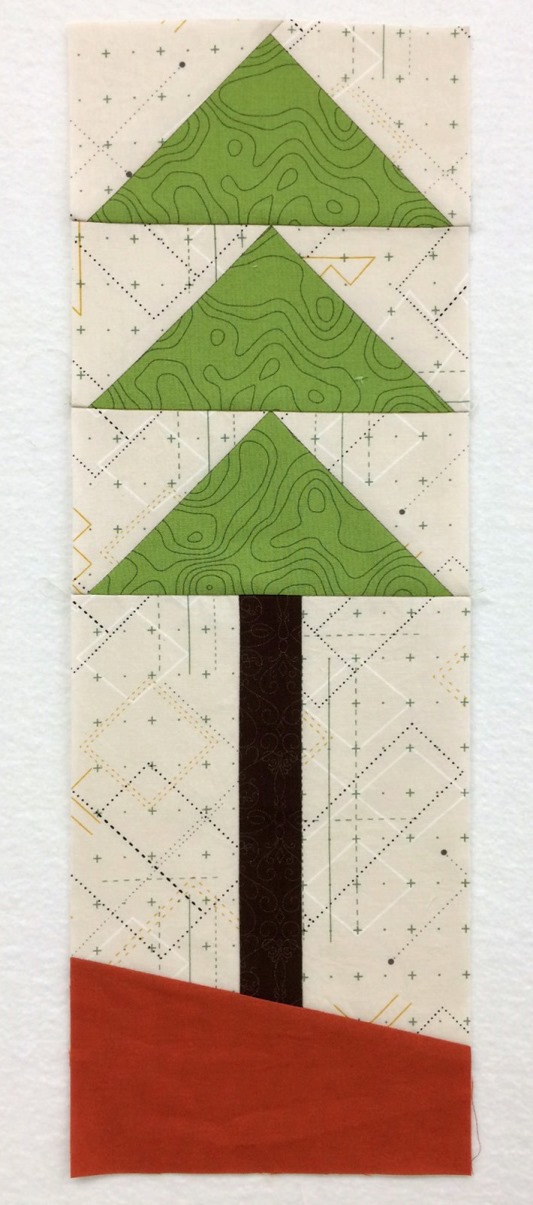
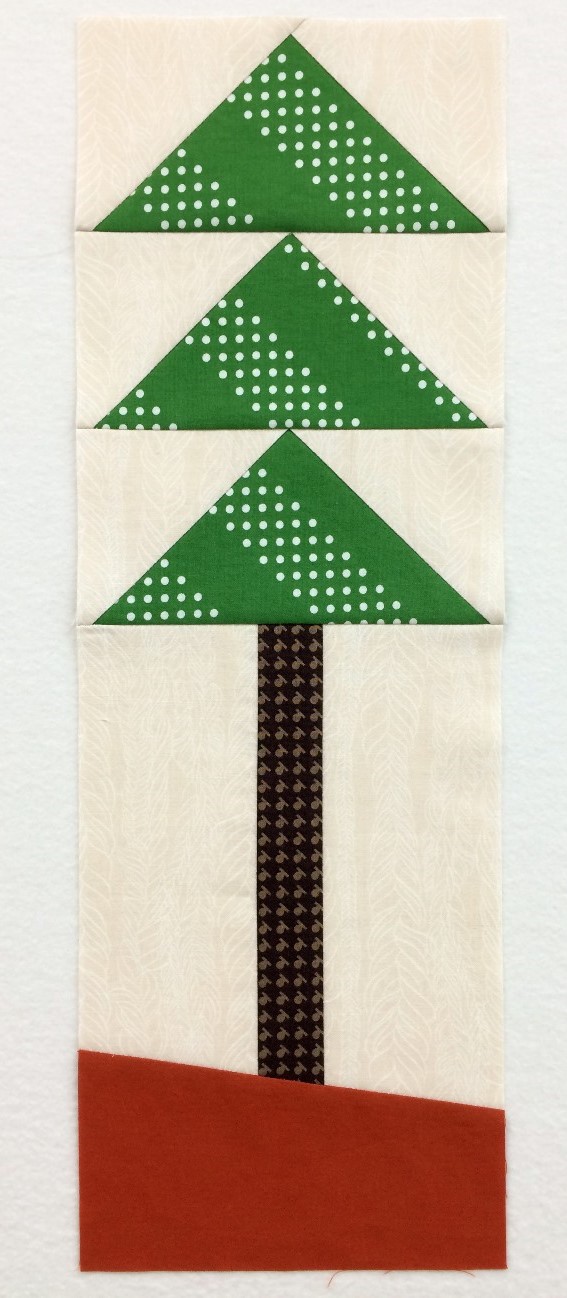 Now you have the idea, let’s start piecing Planted Pines.
Now you have the idea, let’s start piecing Planted Pines.
Flying Geese Units
We will start with the Flying Geese units. These measurements are for the sew and flip method for 1 flying geese unit, but you are welcome to use the 4 at a time method.
You will need:
- (2) Background squares 3 1/2″ x 3 1/2″
- (1) Green rectangle 6 1/2″ x 3 1/2″
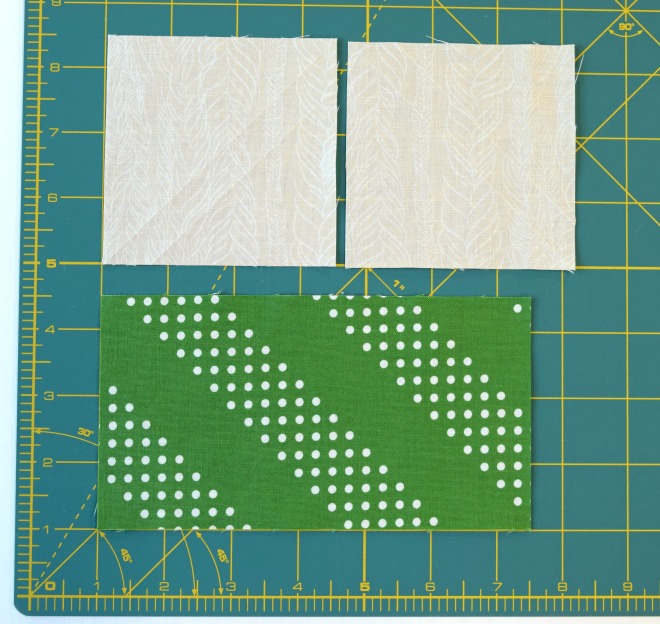 Draw a line diagonally from corner to corner, I used a hera marker. I also marked a line 1/2″ away from the first line. I plan to make bonus half square triangles (HSTs).
Draw a line diagonally from corner to corner, I used a hera marker. I also marked a line 1/2″ away from the first line. I plan to make bonus half square triangles (HSTs).
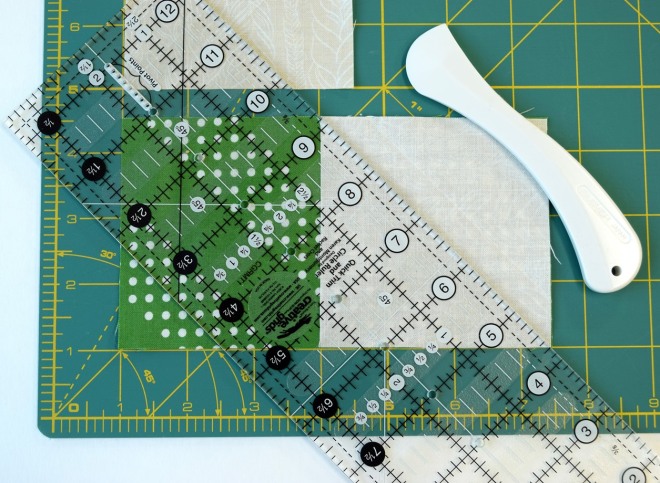 Stitch on one or both lines.
Stitch on one or both lines.
 Trim the seam allowance to 1/4″ or cut between the two sewn lines. TIP: If you press and set the seam(s) before you trim, you will have less distortion when pressing the bias seams. Since I am making the bonus HSTs, I flipped the unit over and pressed the seam toward the dark.
Trim the seam allowance to 1/4″ or cut between the two sewn lines. TIP: If you press and set the seam(s) before you trim, you will have less distortion when pressing the bias seams. Since I am making the bonus HSTs, I flipped the unit over and pressed the seam toward the dark.
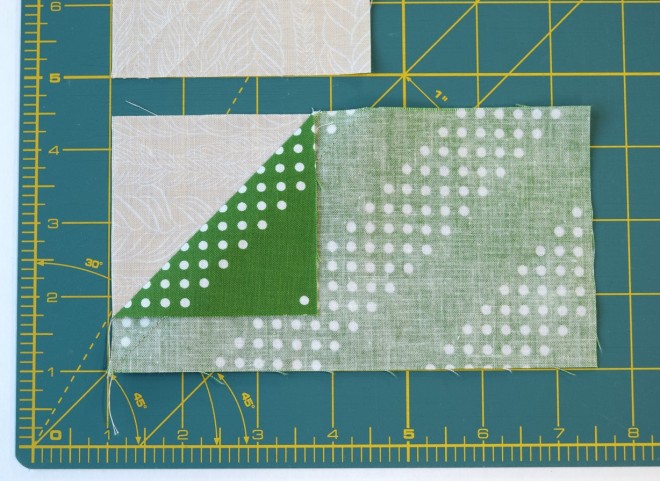 Repeat with the other background square on the opposite side.
Repeat with the other background square on the opposite side.
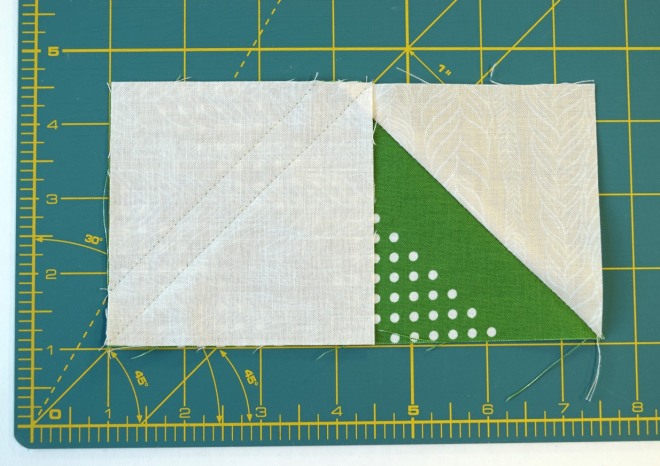 And now you have one flying geese unit. Repeat to make a total of 2, 3 or 4 flying geese. Sew the geese together with a scant 1/4″ seam. Press the seams toward the top of the tree.
And now you have one flying geese unit. Repeat to make a total of 2, 3 or 4 flying geese. Sew the geese together with a scant 1/4″ seam. Press the seams toward the top of the tree.
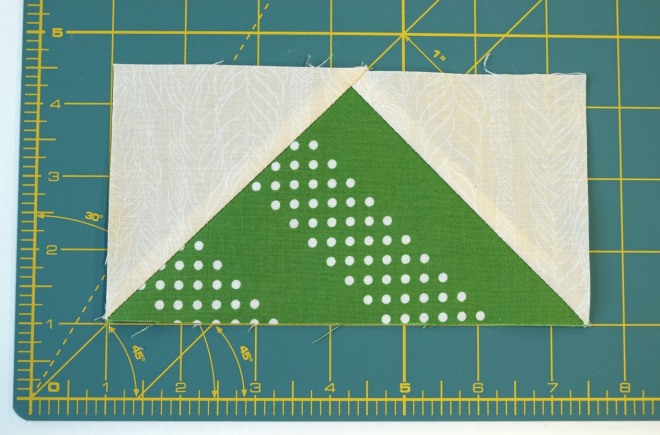
Update 11/1/17 – For making flying geese using the 4 at a time no waste method: Cut (1) green square 7 1/4″ and (4) background squares 3 7/8″. Generations Quilt Patterns has a nice tutorial.
Tree Trunk
Let’s move on to the tree trunk. The measurements here will result in a tree trunk that finishes at 1″ wide. But feel free to adjust your cutting to make a skinnier or fatter tree. You will need:
- (1) Background rectangle 6″ wide x approximately 8″ long (can vary depending on the number of flying geese units your plan to incorporate in to your block)
- (1) Brown rectangle 1 1/2″ x approximately 8″ long
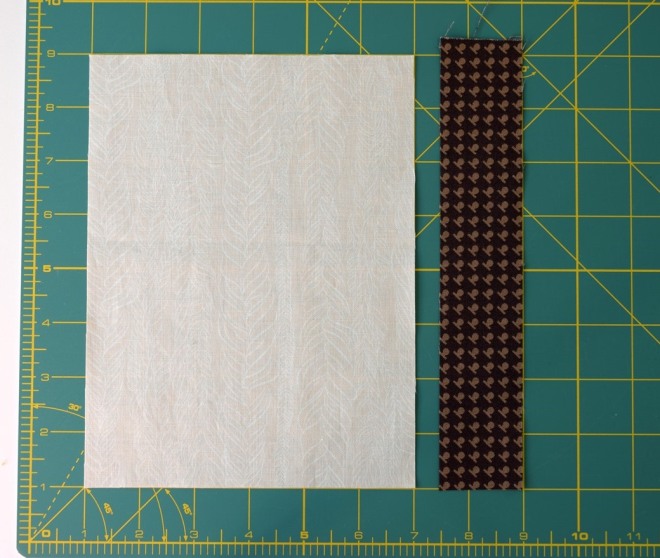 Cut the background rectangle in half lengthwise resulting in two smaller rectangles measuring 3″ x 8″ approx.
Cut the background rectangle in half lengthwise resulting in two smaller rectangles measuring 3″ x 8″ approx.
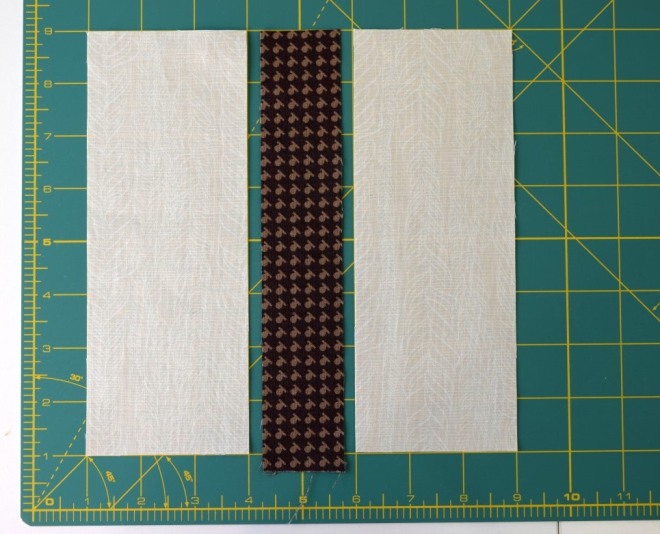 Sew the trunk between the two background rectangles. Press the seams toward the trunk (dark). The important measurement here is the width of the unit which should be exactly 6 1/2″ wide. Trim or square up the sides and the top of the tree trunk unit if necessary.
Sew the trunk between the two background rectangles. Press the seams toward the trunk (dark). The important measurement here is the width of the unit which should be exactly 6 1/2″ wide. Trim or square up the sides and the top of the tree trunk unit if necessary.
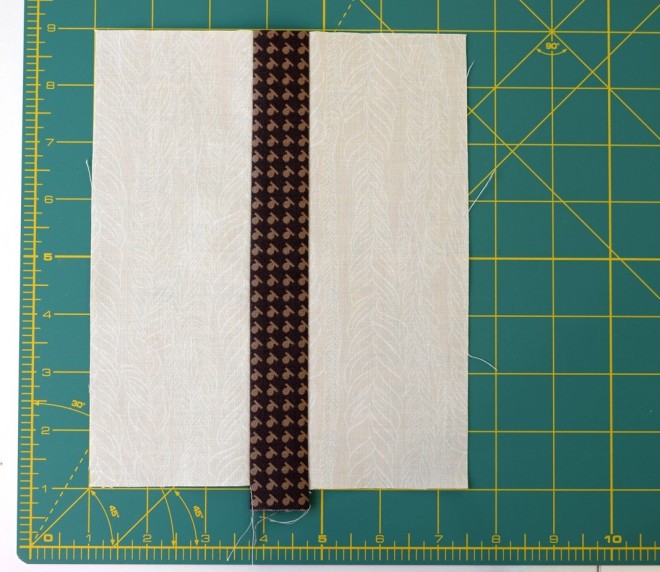
The Ground or Red Hills
I live right at the edge of the mountains so the landscape around here is anything but level. Feel free to make your ground as steep as you like. I will show you how to maintain the straight of grain while piecing the trunk and ground together. You will need:
- (1) Ground rectangle 7″ x 4″ (approximately)
- (1) Tree Trunk unit
Lay the tree trunk unit on your cutting mat and decide the angle of your ground. You can audition the slope with your ruler.
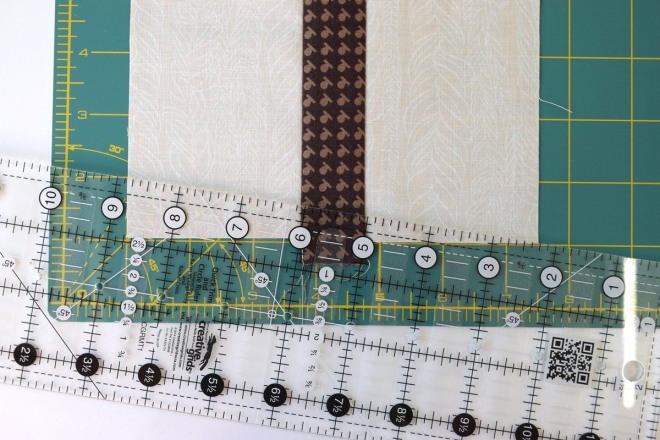 Leave your ruler in place and make the cut.
Leave your ruler in place and make the cut.
 Lay the ground rectangle on your cutting mat like so. Place the tree trunk unit over the ground fabric centering it from side to side and keeping the sides parallel to to the lines on your cutting mat.
Lay the ground rectangle on your cutting mat like so. Place the tree trunk unit over the ground fabric centering it from side to side and keeping the sides parallel to to the lines on your cutting mat.
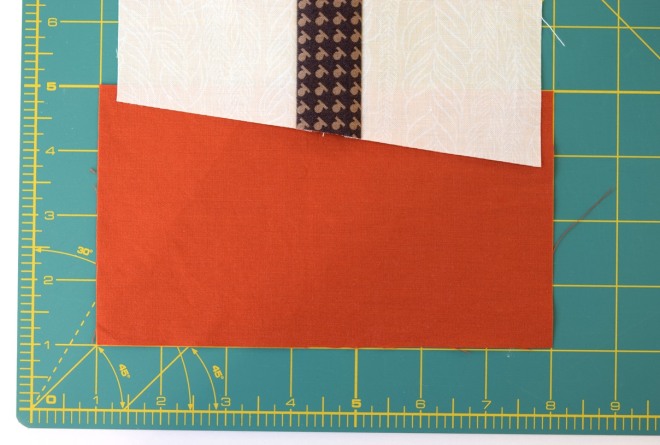 Place your ruler along the bottom edge of the tree trunk unit and cut on the angle.
Place your ruler along the bottom edge of the tree trunk unit and cut on the angle.

The tree trunk and ground should look like this. The ground should be wider than the tree trunk unit.
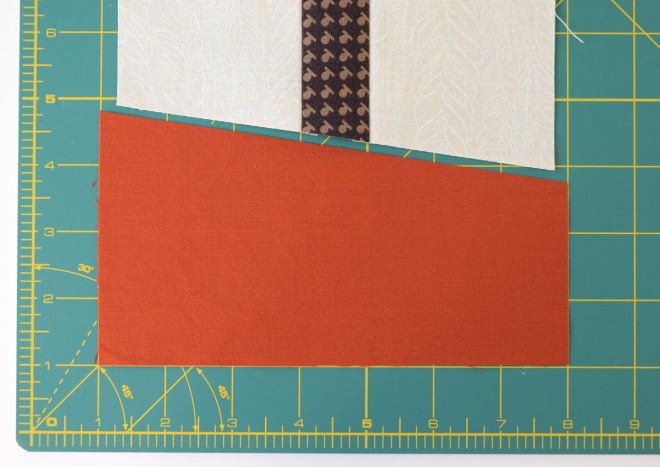 Flip the tree trunk unit down toward the ground and align the raw edges. The ground fabric should extend beyond the tree trunk on both sides.
Flip the tree trunk unit down toward the ground and align the raw edges. The ground fabric should extend beyond the tree trunk on both sides.
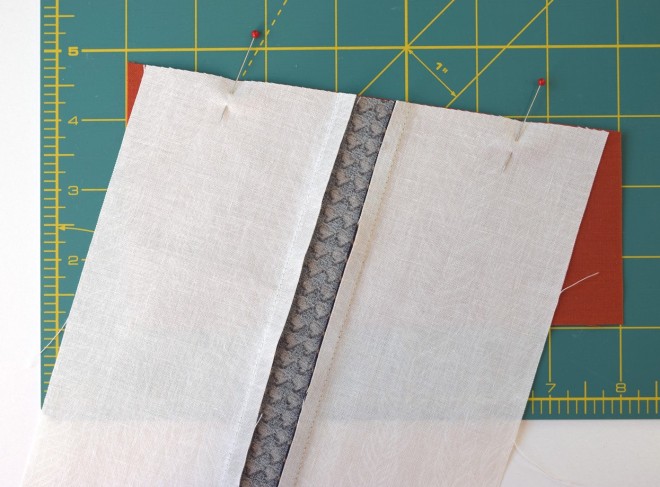 Stitch with a scant 1/4″ seam allowance. Press the seam toward the ground fabric.
Stitch with a scant 1/4″ seam allowance. Press the seam toward the ground fabric.
 Trim the ground to 6 1/2″ wide. A 6 1/2″ rule makes trimming a breeze.
Trim the ground to 6 1/2″ wide. A 6 1/2″ rule makes trimming a breeze.
 See how center of the center of the ruler goes right down the center of the tree trunk?
See how center of the center of the ruler goes right down the center of the tree trunk?
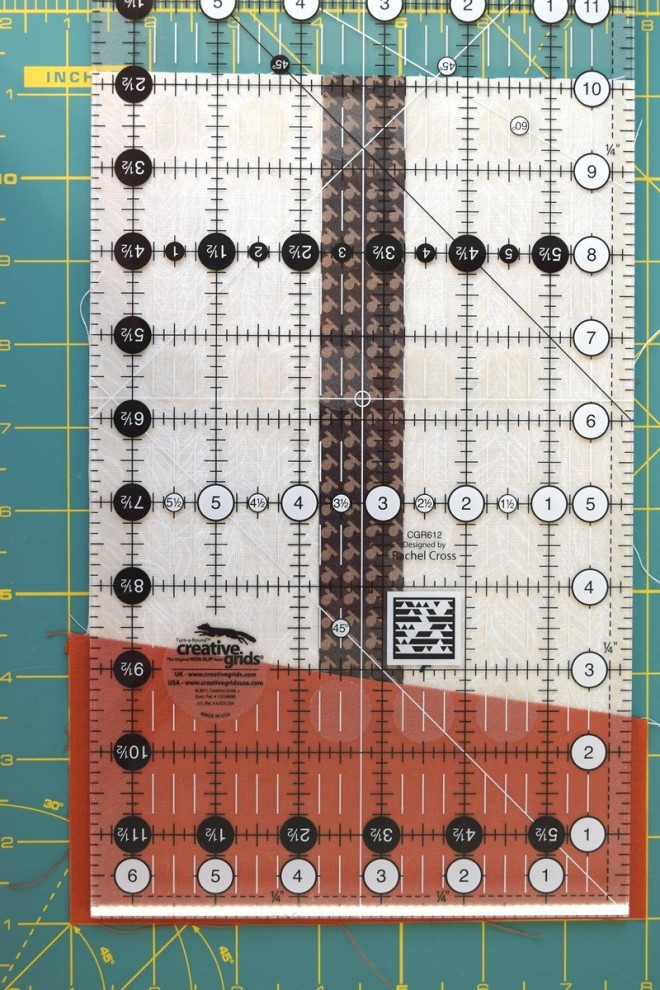 It should look like so after trimming up, 6 1/2″ wide by aprox. 10″ tall.
It should look like so after trimming up, 6 1/2″ wide by aprox. 10″ tall.
 Join the flying geese and tree trunk/ground to complete the block. The block should be 6 1/2″ wide. The length should be approximately 18 1/2″, but if it is shorter or longer, it’s fine and you’ll see why in a bit. Congratulations, you’ve completed a Planted Pines block.
Join the flying geese and tree trunk/ground to complete the block. The block should be 6 1/2″ wide. The length should be approximately 18 1/2″, but if it is shorter or longer, it’s fine and you’ll see why in a bit. Congratulations, you’ve completed a Planted Pines block.
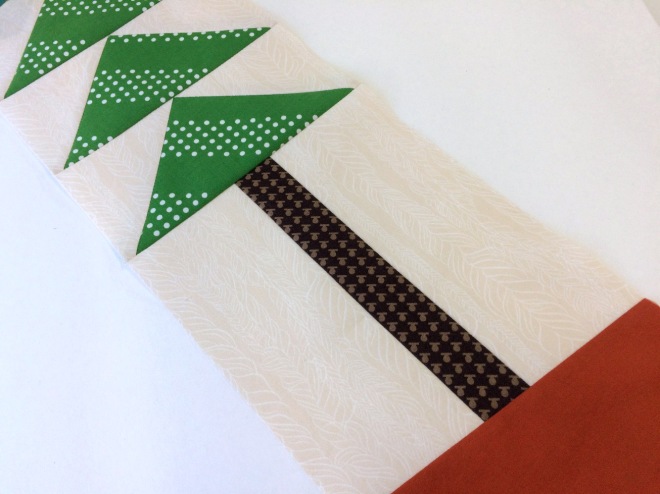
More about the Trees and Ground
This is a beautiful sunset behind the pines.
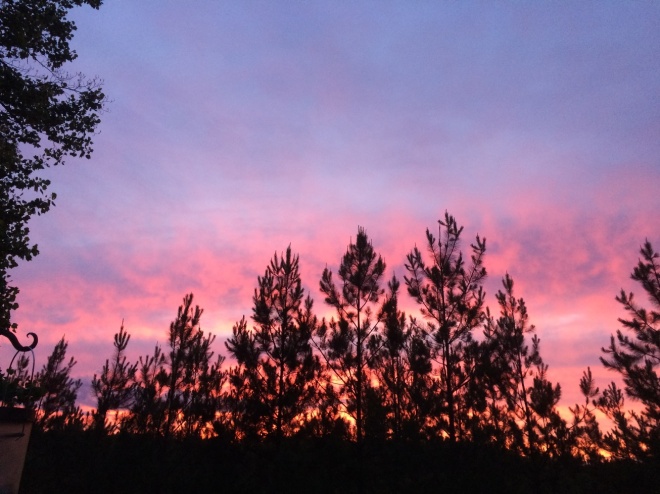 The trees were thinned this summer and here is a glimpse of the operation.
The trees were thinned this summer and here is a glimpse of the operation.
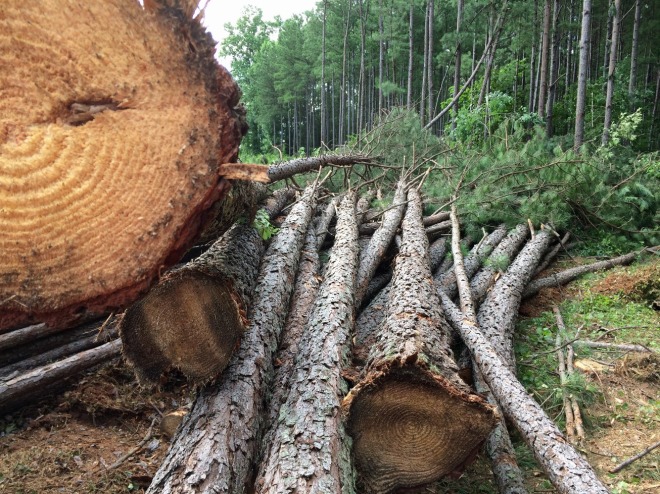 The trees are sorted into chip-n-saw for making waferboard used in new construction and into pulp wood for making paper. I would like to think its going to make the cardboard bolts for holding fabric but there’s no way to know.
The trees are sorted into chip-n-saw for making waferboard used in new construction and into pulp wood for making paper. I would like to think its going to make the cardboard bolts for holding fabric but there’s no way to know.
The trees are cut to length for hauling. Look at the size of that blade.
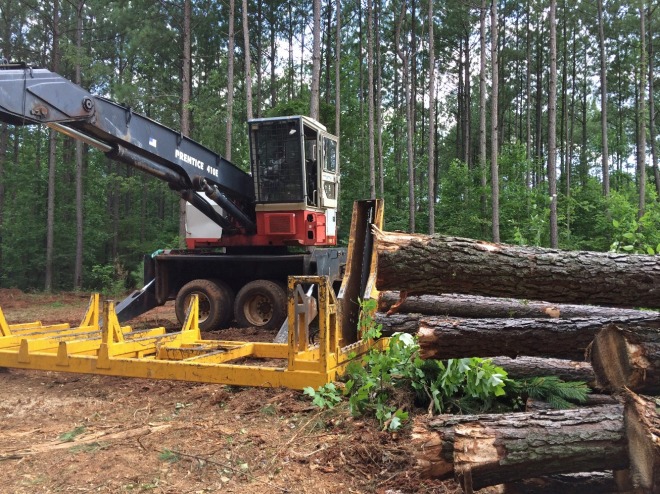 There is always the chance of loosing trees from high winds or ice build up. This tree was blown over in a recent storm.
There is always the chance of loosing trees from high winds or ice build up. This tree was blown over in a recent storm.
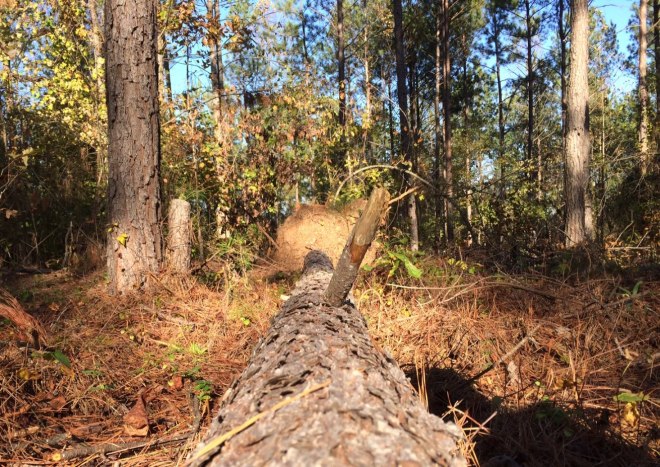 I’m not exaggerating about the color of the red clay in the soil. This is a photo of the root ball from the fallen tree. That’s why I picked out this solid from In the Beginning Fabrics. The color is burnt orange and I found it at my local quilt shop.
I’m not exaggerating about the color of the red clay in the soil. This is a photo of the root ball from the fallen tree. That’s why I picked out this solid from In the Beginning Fabrics. The color is burnt orange and I found it at my local quilt shop.
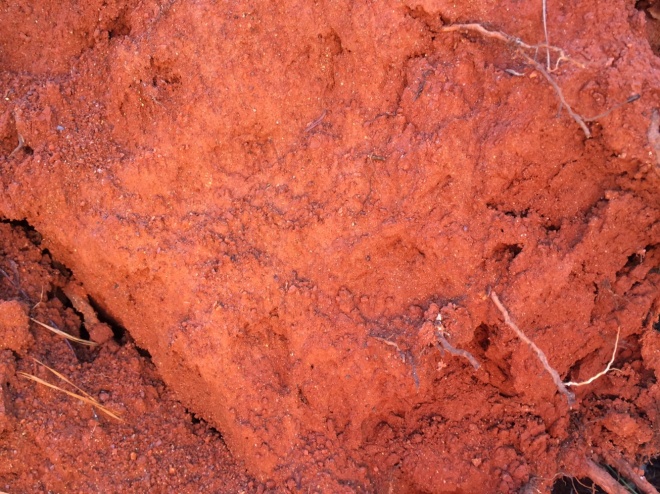
Planted Pines Quilt Layout
This is the layout I have planned for the Planted Pines quilt blocks. The blocks will be sewn into vertical rows with spacing added as needed to complete each row. That’s the reason why the length of the blocks is not as critical.

I plan to make a lap quilt. I mailed each of my Bee Inspired bee mates 2 pieces of ground fabric, but if you only have time for one block, that’s just fine. I look forward to building my tree farm from your blocks. Please share your block(s) on social media #PlantedPinesQuilt and tag me @QuiltedBlooms.
Poodle Block for Karen
A poor little lost doggie will be finding his way soon to Karen’s house. Karen was queen bee in June and wrote several posts, starting with this one, about her trip to Paris and some wonderful tips for piecing the pooch. You can read more about making this block in this post and this one. I’ve got one more doggie to make for Ann and will do so very soon!
You can read more about making this block in this post and this one. I’ve got one more doggie to make for Ann and will do so very soon!
Inside Addition Block for Sue
For February we are making 12 1/2″ Inside Addition blocks for Sue at Seven Oaks Street Quilts.

The block went together quickly. Using the Blocloc HST ruler certainly helped with trimming the HST units.

Sue asked us us share a little about where we live and since I live near GREENville, South Carolina, I decided to make a green monochromatic block for Sue. I used a Kona Cotton solid for the plus sign, a Denyse Schmidt for the coordinating green and a Bonnie and Camille low volume print for the background.

Here’s a map showing Greenville, South Carolina is located in the southeastern US.

This is the Liberty Bridge which spans the Reedy River in downtown Greenville and was taken after a big rain.

This is the historic Huguenot Mill built in 1882 and is one of Greenville’s olded structures. I took this picture after a summer rain and loved the reflection in the water.

I met some friends down at the water’s edge, but didn’t have any snacks to share with them.

I mailed my block last week and hope it makes it to Sue in Austrailia safely. I’ll leave your with what’s blooming right now in my yard, some pretty daffodils.
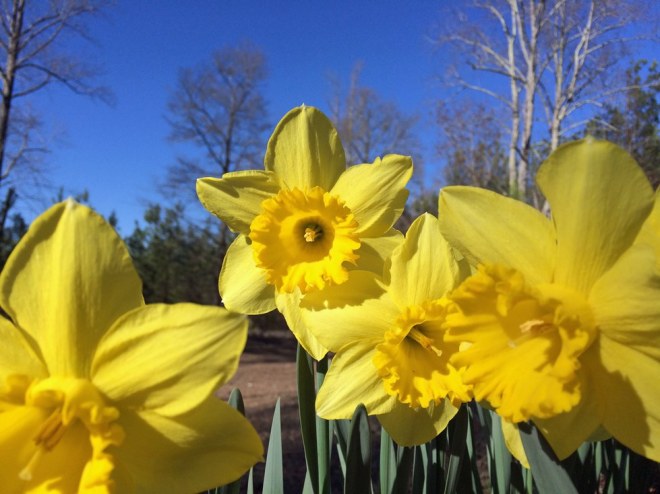
Paige at Quilted Blooms

